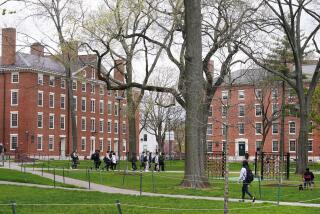U.S. 4th-Graders Score Strongly in Science, Math
- Share via
American 9- and 10-year-olds were among the sharpest in the world in science and, for the first time ever, also performed well above average in math in a new international comparison released Tuesday.
Korea beat the rest of the world in science while Japan and the United States were close behind. In math, seven countries--led by Singapore, Korea, Japan and Hong Kong--were clustered at the top. The United States, though above average, was in a second tier with six countries, including Slovenia, Ireland and Israel.
The strong performance of U.S. students in this age group on the Third International Math and Science Study contrasts sharply with the relatively weak showing of its 13-year-olds. In results announced last fall, the older students were only average in science and below average in math.
U.S. students make less progress between the fourth and eighth grades--in either subject--than their counterparts in any of the 26 participating countries, according to an analysis by the organization that gave the test, the International Assn. for the Evaluation of Educational Achievement.
Though education experts said they could not be sure why U.S. students fall behind after the fourth grade, the most common theory pointed toward what students are taught--lessons at the higher grades that are less in-depth or challenging than in other nations.
In a ceremony at the White House, President Clinton said the showing by the U.S. students indicated that “we are doing a very good job in the early grades, but we’ve got a lot of work to do in the later ones.”
“There are a lot of people who never believed the United States children would score in the top two in the world on any of these international tests,” Clinton said. “And now, they know they were wrong and they underestimated our children [and] underestimated our teachers.”
But he said the drop-off between fourth and eighth grade shows that “our curriculum will have to be more focused and more demanding. We know we’ll have to hold all of our students to higher standards as they grow older.”
Clinton reiterated his proposal to monitor students’ progress by giving eighth-graders a math test, pegged to international standards, starting in 1999.
The comparisons released Tuesday were drawn from the most ambitious effort ever to test students and gather information about their study habits, leisure activities and schools’ teaching methods.
More than half a million students and their teachers in more than 40 countries participated in the testing program, administered mostly in 1995, and education researchers expect to mine the data for years to come.
Study director and Boston College education professor Albert Beaton said the initial analysis does not reveal any panacea for boosting student learning. Neither does it show that reforms often proposed in the United States--more time in class or a smaller ratio of students to teachers--automatically produce results.
Top-scoring Korea, for example, has the largest classes in the world, averaging 43 students. And U.S. teachers assign more homework than in countries where students performed better. One finding consistent in all countries was that most teachers say that coping with differences in the ability level of their students slows down lessons.
“If there were simple answers, somebody would have found them,” Beaton said.
There did appear to be a connection, however, between academic achievement and factors outside the classroom. Students whose homes had large numbers of books, a desk and computer did better than those whose homes lacked them. The report notes, though, that it is not the books or computers themselves that made the difference--but the parental support for education that they signaled.
The most dramatic finding for the United States was how little children here learn between the fourth and eighth grades in math or science. Earlier studies have reached similar conclusions but have been criticized for technical shortcomings.
“Now we not only see the magnitude of the drop-off . . . but we really have some good ideas of why that is likely to be the case,” said William H. Schmidt, a Michigan State University professor who coordinated the new research in the United States. “That’s what’s so powerfully important from these results.”
Schmidt said what American students are taught in fourth grade is in line with what students learn elsewhere--meaning that U.S. students can master challenging material when they are expected to. But American classrooms don’t move much beyond the fourth grade lessons in grades five through eight, he said.
In math, fourth-graders learn basic arithmetic, fractions, measurement and a little geometry. In science, the American students learn such basics as the body parts and their functions.
Between the fourth and eighth grades, however, other countries teach about seven new topics, such as algebra, while U.S. teachers introduce only one. In science, other countries move on to 11 new topics in areas such as physics and chemistry while American students are learning little that hadn’t been introduced earlier.
“Other countries are not repeating things again and again and why is it that we think we have to?” Schmidt asked.
Gerald Wheeler, executive director of the National Science Teachers Assn., noted that some of Tuesday’s results were good. But, he added, “if we don’t use [them] as a wake-up call, these fourth-graders are going to walk down the same path as the eighth-graders did and four years from now we’re going to be upset wondering why they’re doing just average work.”
Gail Burrill, president of the National Council of Teachers of Mathematics, which has stressed student understanding over calculation, said the reform movement deserves some of the credit for the stronger fourth grade showing.
“It’s rewarding to see that our students are beginning to have some success in math,” she said. “But our hope . . . is to have all students meet higher expectations for all grade levels.”
Some observers of the ongoing controversy over how to teach math were taken aback by the United States’ above-average finish.
“This takes me completely by surprise,” said Hung-Hsi Wu, a mathematician at UC Berkeley who argues for “rigorous emphasis on the basic, technical skills.”
Math lessons in American elementary schools, he said, typically present a series of abstract facts and rules that are to be followed slavishly, resulting in “math phobia.”
“The quality of instruction . . . is so poor that . . . it is difficult in the later grades to get the students to reason,” he said.
Seeming to confirm Wu’s criticism was the fact that U.S. teachers are among the most likely to think that remembering formulas and procedures is very important. Demonstrating the influence of math reformers, however, American teachers also are among the most likely to say that teaching pupils how to use math in the “real world” is important.
Teachers in such high-performing countries as Korea, Japan and Singapore, in contrast, are among the least likely in the world to emphasize “real world” problems.
Another sharp contrast was in the emphasis placed on the use of calculators. In nine of the 11 countries ranked ahead of the United States in math, teachers said they almost never used them in class. In the United States, a third of the teachers said they used calculators at least once or twice a month.
On the math test, U.S. students were strongest in questions requiring pupils to analyze data and understand basic probability and were weakest on fractions and proportions. Told that a recipe using five tomatoes produced a half-liter of sauce, only 43% of U.S. fourth-graders answered correctly that 15 tomatoes would produce 1 1/2 liters.
In science, U.S. students did best on life science questions. Nearly two-thirds knew that the heart serves other parts of the body by pumping blood through them. They were weakest in physical science. Only one in five could draw a line showing the position of the water level inside a watering can as it was being poured.
U.S. girls and boys did equally well in math. In science, however, boys did significantly better.
More to Read
Sign up for Essential California
The most important California stories and recommendations in your inbox every morning.
You may occasionally receive promotional content from the Los Angeles Times.













